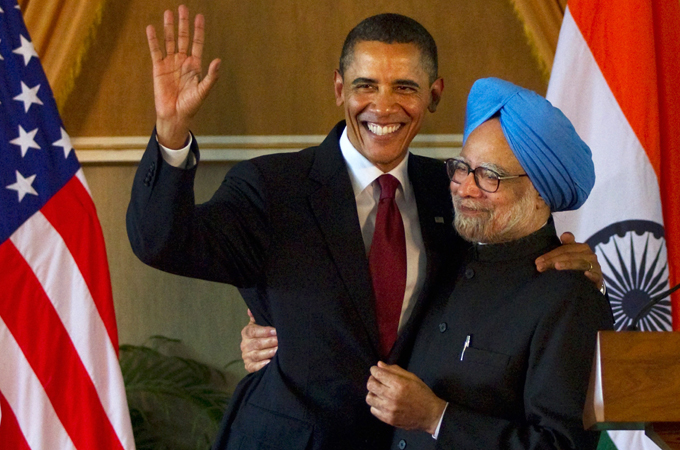Five top world powers visit India
Russian president’s visit to rising South Asian power is on heels of trips by US, UK, French and Chinese heads of state.

 |
| India has been courted by all five permanent members of the UN Security Council [Getty] |
The Russian president’s visit to India comes hot on the heels of several world leaders making appearances in New Delhi, all of them hoping to create jobs back home and make some money.
These diplomatic visits are indicative of the world’s recognition of India’s status as a rising global power, as a key part of the “BRIC” group of rapidly emerging economies, along with Brazil, Russia, and China.
Here’s a look at visits to India by leaders from all five permanent members of the UN Security council – the US, UK, France, Russia, and China – during the second half of 2010.
UK in July
British prime minister David Cameron brought Britain’s biggest-ever trade delegation to the former colony, on a trip that also included visits to Turkey and China.
Cameron, whose massive 90-member delegation included six ministers, called for taking his country’s relationship with India to “the next level” during a visit to the Asian economic giant.
Indian newspapers focused on the massive purchase of scores of British fighter jets and the sheer size and stature of Cameron’s delegation, which also included many corporate executives.
The British government has said private businesses should be the engine of growth, and one of its strategies is to focus diplomatic efforts on fast-growing emerging markets to promote trade.
US in November
In the largest-ever trip by a US president, Barack Obama came for three days, accompanied by some 40 planes and 6 armoured cars. He visited before traveling east to Indonesia, South Korea, and Japan.
Obama’s trip included time in the country’s financial hub, Mumbai, and the capital, New Delhi. During the visit, he emphasised the need to relax trade and investment barriers to boost economic relations between the US and India.
Trade between the two allies totals around $40bn per year, and after Obama’s visit the figure was expected to rise. But some Indian companies expressed concerns about feared outsourcing cuts.
Much to the delight of Indian leaders, the US president endorsed India’s bid for permanent membership on the UN Security Council during a speech to parliament in Delhi.
The president and his wife Michelle also became the most high-profile guests to stay at Mumbai’s Taj Mahal Palace hotel since the attacks two years ago by 10 armed men that claimed 166 lives.
France in early December
On his four-day visit, Nicolas Sarkozy, the French president, signed $9.3bn in nuclear deals with Manmohan Singh, the Indian prime minister.
There were some concerns that India’s recently passed liability law might prove too strict for international companies to risk entering the market. But Indian officials assured France that the new laws were in keeping with international standards and the security of nuclear operators was ensured.
Sarkozy and Singh also met to discuss regional security, trade and investment. Talks touched on plans for structural reform of the international monetary system through the Group of 20 countries, currently headed by France.
Sarkozy was accompanied by his defence, foreign and finance ministers and nearly 60 business leaders.
France has pushed to win contracts to supply military hardware to India, which is expected to spend $80bn upgrading its armed forces between 2012 and 2022.
China last week
Wen Jiabao was in India so the two Asian giants could talk trade. The visit, the first by a Chinese premier to India in five years, appeared to have been carefully choreographed to improve ties.
While the visit stirred political controversy, China reiterated its support for India’s aspirations to play a greater role in the Security Council – though it stopped short of expressing full backing for India.
While the two are often lumped together as emerging world powers, China’s GDP is four times bigger than India’s, and its infrastructure outshines India’s dilapidated roads and ports, a factor making New Delhi wary of Beijing’s growing might.
Wen, who traveled next to Islamabad, came to India with 300 business leaders and said that India and China were not rivals and that there was enough room in the world for both powers to develop.
China is already India’s largest trade partner, and two-way trade is expected to reach $60bn in 2010. Chinese leaders aim to reach $100bn in trade between the rising Asian powers by 2015.
Russia this week
Dmitry Medvedev, the Russian president, is arriving in India on Tuesday for a two-day visit. The Russian leader made his first official visit in 2008 to discuss joint defence and civil nuclear projects.
Medvedev is expected to sign a $30bn deal to supply fighter jets to the Indian air force that are the Russian equivalent of the F-22 Raptor.
India and Russia are also likely to discuss reforming visa policies as part of a plan to double annual bilateral trade from the current $10bon in the next five years.
In March, Vladimir Putin, Russia’s premier, was in India to cement lucrative deals, including plans to build 12 nuclear reactors in India, half of them by 2017, and sell an aircraft carrier.
Energy is emerging as a new focus of co-operation between oil and gas-rich Russia and energy-starved India, which is always on the lookout for new fuel sources to power its growing economy.
The strong ties between Moscow and New Delhi date back to the 1950s, but India has in recent years balanced this friendship by fostering much closer relations with the US.